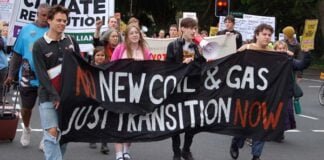Malcolm Turnbull has not just adopted Abbott’s policies on climate change, he is taking them further, as his government wages war on renewable energy in the wake of the September state-wide blackout in South Australia.
Turnbull himself launched the attack, saying the blackout was a “wake-up call” and accusing state Labor governments of adopting, “renewable targets that are… extremely unrealistic”. He claims renewable energy is a threat to “energy security” that could cause future blackouts.
This year is likely to become the hottest on record for the third year in a row, based on temperatures to the end of September that were 0.99 degrees warmer than average. The need for action on climate change is growing more and more urgent.
Renewable energy supplies 41 per cent of South Australia’s power, the highest in Australia, mainly from wind farms. The blackout was the result of an extreme storm that knocked down 22 transmission lines and produced 20,000 lightning strikes.
Opponents of renewable energy have seized on reports from the Australian Energy Market Operator showing that disconnections from the grid by wind farms helped trigger the blackout. This was caused by automatic safety settings that took them offline in response to continual shocks to the electricity system. As South Australian Treasurer Tom Koutsantonis put it this was, “a software issue—not a problem with renewable energy”.
Renewable targets
The Coalition have seized on the blackout as a pretext to undermine renewable energy. The federal government has a renewable energy target of 23.5 per cent by 2020. But this target was cut by 20 per cent last year. Beyond this there is no plan to raise the use of renewable energy further.
The simple fact is that the Coalition lacks any credible policies to achieve their promised target of reducing carbon emissions by 26-28 per cent by 2030.
Labor state governments have set renewable energy targets of 50 per cent by 2030 in Queensland, 40 per cent by 2025 in Victoria and 50 per cent by 2025 in South Australia.
Turnbull’s Energy and Environment Minister, Josh Frydenburg, has revived the discredited claim that wind and solar provide only “intermittent power” and are a therefore a risk.
But as renewable energy expert Mark Diesendorf wrote earlier this year, “The north German states of Mecklenburg-Vorpommern and Schleswig-Holstein are already operating on 100% net renewable energy, mostly wind.”
In Australia, detailed studies of electricity demand by Diesendorf and fellow UNSW academics as well as Beyond Zero Emissions and even the Australian Energy Market Operator have shown that through, “relying on multiple technologies and spreading out wind and solar PV farms geographically”, it is possible to power the country on 100 per cent renewable energy.
While wind and solar power may be intermittent in one area when the wind is not blowing and the sun not shining, when spread across a number of locations their reliability is radically increased. Battery and other storage technology, such as at large solar thermal plants, will help further.
Frydenburg has also claimed state government renewable energy targets would mean “dramatic costs” on power bills. But he was caught telling porkies, after he claimed Queensland’s renewable energy target of 50 per cent would cost $27 billion in building new renewable power generation. An independent report for the Queensland government released a few days later found the likely cost would be around $6 billion.
The report envisages the private sector would build the renewable power plants, and that the government construction subsidy of between $500 and $900 million would be completely offset by lower power prices. This is because renewable energy is much cheaper to generate than coal or gas plants once it is built. Government ownership of the plants could mean even cheaper power.
So it is a complete myth that 50 per cent renewable energy would drive up power bills.
The weakness in Queensland’s proposal is that it would not see the closure of any existing coal power plants, although their operators would lose revenue.
The Climate Change Authority, in a report last year, said Australia needed to reduce carbon emissions by 45 to 65 per cent by 2030. The most straightforward way to do this is to move to zero emissions from power generation as quickly as possible.
The Australian Energy Market Operator’s report suggests that Australia could have 100 per cent renewable energy by 2030, but power prices might be around 25 per cent higher. But there is no reason ordinary people need to pay increased power bills. By increasing taxes on the polluting corporations that profited from using fossil fuels, the costs could easily be met.
By James Supple





